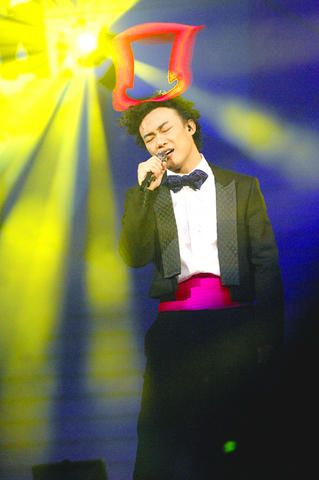NT$250 million. That's how much accident insurance promotion company MN Wingman (大國翼星) took out on Canto-pop crooner Eason Chan (陳奕迅) for his one-off concert at Zhongshan Soccer Stadium (中山足球場) tomorrow.
The company felt it was necessary because at Chan's last performance in Taipei, the Hong-Konger fell from a set and injured "an important area" of his body, said Kimmi Lin (林宜君), an MN Wingman spokeswoman.
Like many Canto-pop stars, Chan got his start in 1995 after participating in and winning an International New Talent Singing Competition (新秀歌唱大賽), an annual event held in Hong Kong by Television Broadcasts Limited. He signed with Capital Records and since then has fully committed himself to music.

PHOTOS COURTESY OF MN WINGMAN
Unlike many of the saccharine stars discovered by Taiwanese "talent" shows, however, Chan does actually have talent. In addition to being a skilled singer and songwriter, he plays the piano, drums and guitar among other instruments.
Chan, who in 2003 won the Best Male Performer Golden Melody Award is the second non-Taiwanese singer to earn an accolade at the ceremony (the first was Jacky Cheung, 張學友). He has also won Hong Kong's Most Popular Male Singer Award for the past two years. His 2005 album, U87, was hailed by Time magazine as one of Asia's top five CDs worth buying (his most recent is Listen to Eason Chan).
Tomorrow will be the singer's first major concert in Taiwan - he's played at small venues and shared stages with other celebrities in the past - and tickets are going fast.
It's expected to be a lively performance. "He's known to move around quite a bit onstage," Lin said. "He puts on a really frenetic show and never stops moving."
Perhaps it's fitting that more insurance has been taken out on him than any other singer - he beat Sammi Cheng's (鄭秀文) previous record of NT$200 million, which was set seven years ago.

This month the government ordered a one-year block of Xiaohongshu (小紅書) or Rednote, a Chinese social media platform with more than 3 million users in Taiwan. The government pointed to widespread fraud activity on the platform, along with cybersecurity failures. Officials said that they had reached out to the company and asked it to change. However, they received no response. The pro-China parties, the Chinese Nationalist Party (KMT) and Taiwan People’s Party (TPP), immediately swung into action, denouncing the ban as an attack on free speech. This “free speech” claim was then echoed by the People’s Republic of China (PRC),

Exceptions to the rule are sometimes revealing. For a brief few years, there was an emerging ideological split between the Democratic Progressive Party (DPP) and Chinese Nationalist Party (KMT) that appeared to be pushing the DPP in a direction that would be considered more liberal, and the KMT more conservative. In the previous column, “The KMT-DPP’s bureaucrat-led developmental state” (Dec. 11, page 12), we examined how Taiwan’s democratic system developed, and how both the two main parties largely accepted a similar consensus on how Taiwan should be run domestically and did not split along the left-right lines more familiar in

Specialty sandwiches loaded with the contents of an entire charcuterie board, overflowing with sauces, creams and all manner of creative add-ons, is perhaps one of the biggest global food trends of this year. From London to New York, lines form down the block for mortadella, burrata, pistachio and more stuffed between slices of fresh sourdough, rye or focaccia. To try the trend in Taipei, Munchies Mafia is for sure the spot — could this be the best sandwich in town? Carlos from Spain and Sergio from Mexico opened this spot just seven months ago. The two met working in the

Many people in Taiwan first learned about universal basic income (UBI) — the idea that the government should provide regular, no-strings-attached payments to each citizen — in 2019. While seeking the Democratic nomination for the 2020 US presidential election, Andrew Yang, a politician of Taiwanese descent, said that, if elected, he’d institute a UBI of US$1,000 per month to “get the economic boot off of people’s throats, allowing them to lift their heads up, breathe, and get excited for the future.” His campaign petered out, but the concept of UBI hasn’t gone away. Throughout the industrialized world, there are fears that